History
History of the Loy
Up to the end of the last Century most land was tilled by hand with the use of the loy or similar tools. In some of the Southern Counties, the loy was known as a FACK (Irieac). There is much evidence in many of our fields with tracks and ridges of bygone days both for grain and potatoes. Spade ridges from beneath the blanket bogs in North Mayo's Ceide Fields date back over 4,000 years to the Bronze Age. So the Loy or similar tools go back further than the recent past. Some may believe that the Loy was the implement of the poorer farming areas of Ireland, but on the
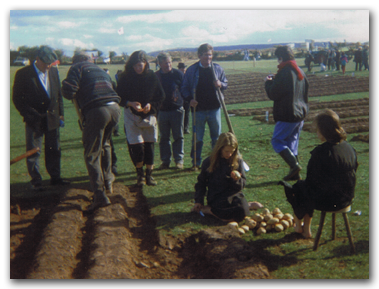 |
| Re-enactment of historic potato planting using the Loy |
contrary, the plough was much inferior for good tillage. There is an account of farmers, on the more fertile land's of Tipperary & Kilkenny who found it more economical, taking labour costs and crop return into consideration to till the big fields with the Loy or Fack rather than the plough. Of course the plough is much improved since then in design and through the work of our ploughing matches, etc.
Every year large numbers of young men from Kerry, Clare, Mayo to Donegal, made their way inland to the hiring fairs at which the farmers made bargains for their spring work to be done, (known as the Spailpini fanacha) who were such familiar figures in Ireland at that time. Across the world, the Irish were noted for their physique and skill in the use of hand tools such as the spade, who built the railways and canals around the world.
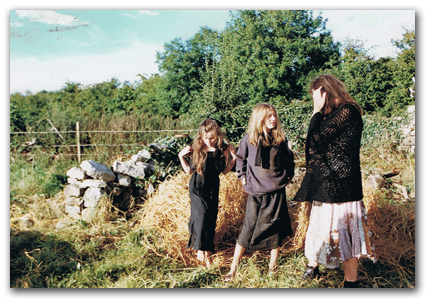 |
| Re-enactment of a famine scene with Patricia Lane and her daughters |
Every area had it's own design of the Loy depending on the soil conditions. The loy you see here today is of the North midlands. (Leitrim, Cavan & Longford) or any area with similar soil conditions. It's design is for heavy drumlin soils, with a long narrow iron mounted on a long handle with a deep heel for leverage All these loys are one-sided to suit a left or a right foot.
The Loy Association of Ireland was founded on July 31st. 1992 in the County Hotel, Carrick-On-Shannon, Co. Leitrim. Who's aims are to foster this ancient craft which has almost become extinct. It is encouraging that an interest in it's revival is taking place. It is now a major attraction at the National Ploughing Championships and drawing much interest from abroad. In 1988 there was only one county (Leitrim) with two competitors hosting Loy Digging Competitors. Now there are over 10 counties. The loy is uniquely Irish. It's characteristics are weed-control and drainage which cannot be surpassed by the most modern technology of today. We are fortunate that the custodians of its use are with us still. We should be grateful to the people who saved it for us. God be with the tool that fed our nation. Long may its use continue. “Work hand & foot, work Loy & Hand The Blessed fruit that grows from the root is the real gold of Ireland"
Eamon Egan,
Secretary, Loy Assoc.of Ireland.
The Loy Association, A Brief History
| AGM of The Loy Association of Ireland - Sunday 14th December 1997 - Bridge House, Tullamore, Co. Offaly |
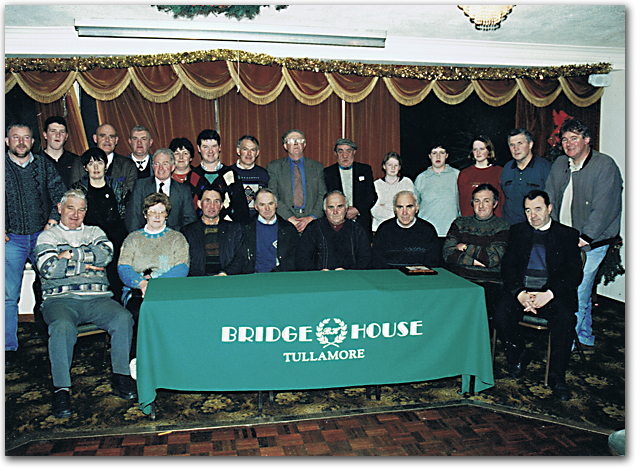 |
| Back row L to R: 1. PJ McStay - Cavan, 2. Glenn Campbell - Longford, 3. Shelia Hoctor - N.Tipp, 4. Larry Egan - Offaly, 5. Pat Campbell RIP - Longford, 6. Packy O'Brien - N.Tipp, 7. Peggy Campbell - Longford, 8. Terry Moore - Westmeath, 9. Alex Hunter - Sligo, 10. Matt Connell - Longford, 11. Barney Kiernan RIP - Longford, 12. Laura Connell - Longford, 13. Patricia Campbell - Longford, 14. ?, 15. ?, 16. MI McNally - Longford Front row L to R: 1. Willie Cunningham - Sligo, 2. Rose McKeon - Longford, 3. MI McKeon - Longford, 4. Geo Hunter - Sligo, 5. Eamon Egan - Longford, 6. Tom Egan - Westmeath, 7 Bernie Casey - Longford, 8. Tom Maher - Offaly. |
The Loy (Irish for spade) is a simple but unusual looking implement with an iron head and a wooden handle. This is the tool that was used in this country for turning the sod. It’s not known how old the Loy is or when sod turning started in this country. We don’t know what the Ceidi Fields in Mayo were tilled with five-thousand years ago – all we do know is that there is no evidence of any other sort of implement for tilling. There have been old iron loy heads found in practically every county in Ireland.
 |
| Pat Murphy - Co. Wexford Dry stock and tillage farmer - Under 14 & Under 16 All Ireland Champion at the Tullamore Show. Current Senior All Ireland Champion. |
It should be noted that querns, small corn grinding stones thousands of years old, are very commonly found in this country – in order to grow corn you must sow seed in prepared soil. It is reasonable to assume that the Loy was the tool used to prepare the soil for the corn seed.
Old ploughs have been found dating back to the 11th century. Flat dry land was more suitable for using a plough-like implement pulled by a beast of burden. (An old plough was found in Ballinderry near Mullingar, dating to the 11th century.) However, the drumlin soil of the North Midlands – Longford, Leitrim, Cavan, and Roscommon – was generally wet and fertile, with a great supply of organic matter. It also featured deep rooted grass and rushes with wire-like roots, unlevel and, in some areas, stony. The only tool suitable for turning this sort of sod was the Loy. The strong ash handle and tapered-out heel gave great leverage in virgin soil. Meanwhile, the soft wet underlying soil became drained with the making of high ridges with deep furrows, especially on small farms.
The characteristics of this ridge were weed control and drainage which cannot be surpassed by the most modern technology. There is a belief that Loy tilling was only practiced in remote areas where horses could not travel. On the contrary, Loy tilling was very common in wetland areas where record yields of potatoes were produced. This could apply to any of the thirty two counties of Ireland. By the start of the nineteenth century the factory spade was about to take over from the Loy in most areas.
The exception was the North midlands – Longford, Leitrim, Roscommon, and Cavan. The Loy hung on, being more suitable for turning the wet soil particular to this area (as described above). In this part of the country the Loy was commonly used until about 1950 or 1960. By then most of the land was suitable for tilling with the tractor and plough. However, the Loy remained part of the farm equipment – every farmer had in his possession 2 or more loys.
At ploughing matches in County Leitrim, there was always a class for Loy digging. About the mid-eighties at a ploughing match in Carrigallon an old man was making a ridge with a Loy. A Ploughing Judge, Eamon Egan, from Longford was there looking at this man digging. As he looked on he was thinking that next year there might be no man digging with a Loy – maybe it was time to do something about it before it was too late. At the time, Eamon was secretary of Longford Ploughing Association.
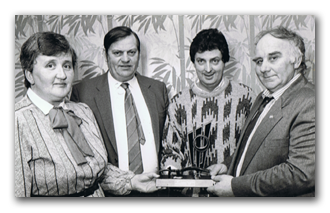 |
| Left to right: Eithna Egan, Raymond White, Brenden Column, Eamon Egan |
This meant that holding a Loy digging contest in Co Longford at a Longford ploughing match would be no great problem. Meanwhile, contestants were available, with help from some of the members of Leitrim Ploughing Association, Mat Casey Snr, Drumlish, and John Madden, horse ploughman from Gowna. Names of old Loy diggers were mentioned, and there was a lot of travelling in an effort to recruit diggers. Three men volunteered. At the 1989 Longford Ploughing Championships in Gurteen, Ballymahon, Eamon Egan put in place the first Loy digging ‘match’ – a trial demonstration - organising three men from Counties Leitrim. They took part, digging three ridges each with a cast off sod. The men were: Tom Heron from Drumshanbo; John O’Malley from Carrigallon; and Charlie McGirl also from Carrigallon.
1990
In 1990 the contest was held at the Longford Ploughing Championship on Raymond White’s farm in Tinalick, Abbeyshrule. John O’Malley, Tom Heron, and John Joe Donnelly competed again. John O’Malley was the winner once again.
1991
The following year, 1991, on James Rowan’s farm in Foigha, Ballymahon, the second Loy contest was held. John Joe Donnelly, Longford, John O’Malley, Carrigallon, and Tom Heron, Leitrim took part. The judge was Raymond White, and John O’ Malley won. Judging was on appearance, neatness, etc and no paper work was done.
1992
1992 was to prove a very significant year, due to three major happenings.
Firstly, on Sunday 8th March 1992 the Longford Ploughing Association again hosted a Loy digging contest on Doyle’s farm at Lislum, Ballymahon. This time score sheets were used in the judging and four counties took part: Longford, Leitrim, Sligo and Westmeath. This was meant to be the first All Ireland contest but events took a surprising turn. The Managing Director of the NPA, Anna May McHugh, and her friend, Monica Carr, were there. They must have been impressed by this new but old way of turning the sod. Eamon Egan talked to them about holding a Loy digging contest at the National Ploughing Championships in Cork later that year. Anna May’s response to Eamon was the land will be available but it must be run by the Loy Association. The contest that day was sponsored by Pat Baker.
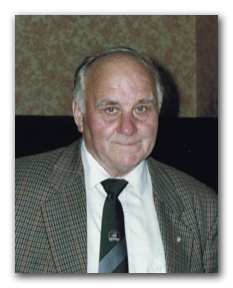 |
| Eamon Egan: Founder of The Loy Association of Ireland |
Secondly, on 31st July 1992 Eamon Egan set up the Loy Association in the Bush Hotel, Carrick-on-Shannon, Co Leitrim.
Thirdly, on Thursday 1st October 1992 at the National Ploughing Championships in Cork, the first real All Ireland Loy Digging Competition at national level, and under the control of the NPA, took place. Five counties competed: Sligo, Leitrim, Cavan, Longford, and Westmeath. The Loy Association appeared to be off to a good start. Partly due to the efforts of the ploughman judge in Carrigallon, our traditional Loy (spade) survived despite threats of being put on hold.
Now, twenty years on, the Loy Association can boast of increasing its membership so much that forty-two competitors in four classes represented sixteen counties in New Ross this year – 2012. The results of the Loy Finals at the National Ploughing Championships are published under 'News'.
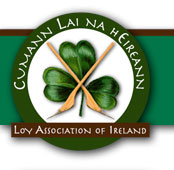
|

|
|
| Home | ||
| History | ||
| News | ||
| Results | ||
| Competition Rules | ||
| Gallery | ||
| Contact |